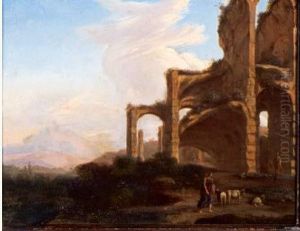Breenburg Bartholomaus Paintings
Bartholomeus Breenbergh (or Bartholomeus van der Breenbergh) was a Dutch Golden Age painter known primarily for his small and highly polished Italianate landscape paintings. Breenbergh was born in Deventer in the Netherlands in 1620. In his early years, he was influenced by the works of the landscape painter Paul Bril. Seeking to advance his skills and broaden his artistic perspective, Breenbergh traveled to Rome around 1619, where he became a member of the group of northern artists known as the 'Bentvueghels,' whose members included other Dutch and Flemish painters working in Rome.
While in Rome, Breenbergh developed a style that blended the realistic observation of nature with the classicizing tendencies of the time. His landscapes typically featured classical ruins or biblical and mythological subjects set in Italian countryside scenes. He often painted in collaboration with other artists, adding landscape backgrounds to their figural compositions.
Breenbergh returned to Amsterdam in the mid-1620s, where he continued to paint and sell his Italianate landscapes. His works were sought after by collectors and proved influential to other Dutch Italianate painters such as Jan Both and Jan Asselyn. Despite his success, not much is known about his life after his return to the Netherlands. He is believed to have died in Amsterdam in 1660. Today, Breenbergh's works are held in the collections of many major museums, and he is recognized for his contribution to the development of Dutch landscape painting.


